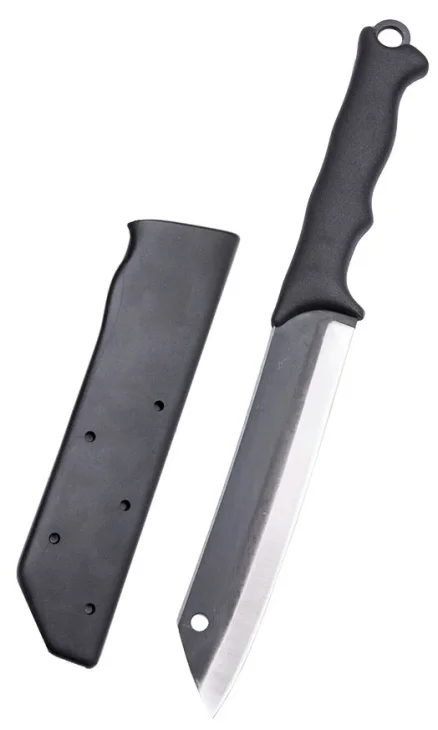
Skrama is a versatile heavy-duty bush knife – a tool that builds shelters, chops firewood, and even whittles kindling! If you're taking just one knife into the bush, get a big Skrama!
- Versatile outdoors knife for chopping, splitting, and whittling
- Ingenious hybrid of a knife and a machete
- Sturdy hand-and-a-half-handed rubber grip gives enough power for chopping but also enables finer work
- 240 mm (9.45") full-tang carbon steel blade
- Made in Finland
- Sturdy sheath available for those who need one
Skrama – as in Scramasax or Seax, a big single-edged knife popular in Iron Age Europe. Much like the Scandinavian Leuku, Skrama doubles up as a tool and defensive implement. A fine name is always nice, and the best ones are those with some history behind them. Our 21st-century Skrama would surely meet the demands of any Iron Age man from "ye good olde days".
This is naturally no axe, nor a precision tool for extremely meticulous work, but something in between and a solid and dependable companion above all.
Anatomy of a Skrama
The blade is slightly curved, with a hole in the tip for hanging. The back of the blade is flat, with no saw teeth or whatnot, perfect for batoning. Do not use a rock, axe, or anything else than wood; it will eventually damage the blade! The full tang construction ends with the bare head of the tang sticking out, with a hole for a wrist strap. The blade may have some small rust stains on the base of the handle due to the manufacturing process. These are harmless and easy to remove.
The blade is sharpened to two different angles. Near the grip, a 5 cm (2") portion has a blade angle of 25° for whittling and fine work. The rest of the blade has a blade angle of 34°, which has proven to be excellent for this type of chopping blade.
Why is there a hole in the blade? It is used when tempering the blades and later during other steps of production. Of course, you can come up with your own uses for it too, but most importantly, it is there for a purpose, not for decoration!
One-and-a-half-handed rubber grip
The handle is designed for a "one-and-a-half-handed" grip. The back end gives a good, solid grip and more power for tough chopping action, for which this bush knife is primarily designed. The upper third of the grip is shaped to give you a good feel for detailed work, such as making firestarters. This is however not a miniature model maker’s scalpel and not intended as one, but as any self-respecting Finnish blade, it can be used to carve a proper wooden cock, "Leirikyrpä" as it's known in Finnish military lingo. The knife is rather well-balanced, so the heavy blade doesn't cause problems when whittling.
Skrama 200 or 240
Welcome to the world of choices. We try to help you with two sentences: Skrama 200 comes out when the regular knife is too short, and Skrama 240 replaces the machete.
Leather sheath
Just like Skrama itself, the leather sheath is designed with practicality in mind and made from excellent materials
- Made from tough 2 mm vegetable-tanned Finnish cow leather
- 60 mm (2.4") wide belt loop fits just about any belt you can find, even those extra-wide military types
- D-ring swiveled belt loop lets the knife turn on your belt, keeping it from getting in the way
- Snug-fitting press-stud strap secures the knife properly in its place. When brand new, the strap may seem "short". Just pull on it a bit or wet it with warm water, and it will soon get a perfect length and shape!
- Grommet for a leg tie at the tip
- Drainage hole at the bottom
Right or left?
The words "Right" and "Left" in the menu might confuse some folks, so let’s clarify it. It refers to your dominant hand, not the side of your body. You pull your knife out of the "Right" sheath with your right hand (normal grip), no matter where the sheath is – left side, right side, or on the front. The "Left" sheath works the same way for the left-handed folks.
If you prefer to pull your knife, e.g., with your right hand from the right side, with your knuckles between your body and the knife handle, only then take the "Left" sheath so the blade edge will face forward. Simple!
Don’t get confused with the Skrama sheath, it has the seam and the tip angle on the other side than the Jääkäri leather sheaths.
Sustainable leather
The leather of Varusteleka sheaths comes from Pelo Leather, a Finnish family-owned Central Ostrobothnian tannery founded in 1897. In addition to producing top-quality sheaths and leather with minimized waste and emissions, the company is respectful of the source of the raw materials: the animals and the nature in which they live.
Pelo Leather uses moose and yak hides provided by hunters and nomads, and cowhides, which are a side product of the dairy and meat industries. The cowhides come from local abattoirs that have standards for ensuring the well-being of the animals. No animals are reared for the sole purpose of producing these leathers.
Their business quarter is 25 years, and a lot of effort is put into the processes and logistics of the business to provide a cleaner environment for future generations. We are proud to have their leather in our sheaths!
Neven S.
Jens S.
Freeman S.